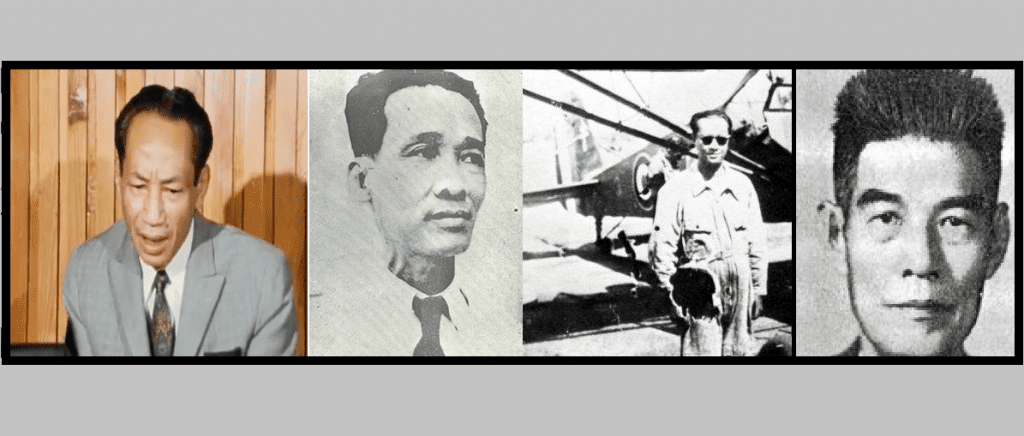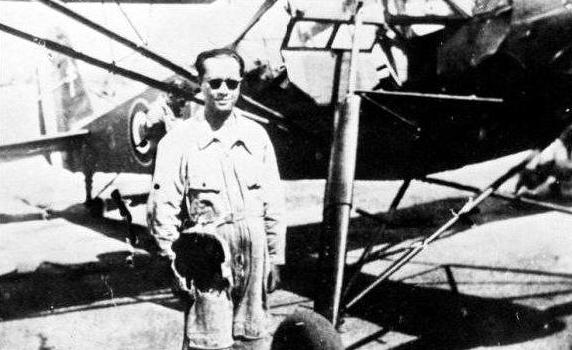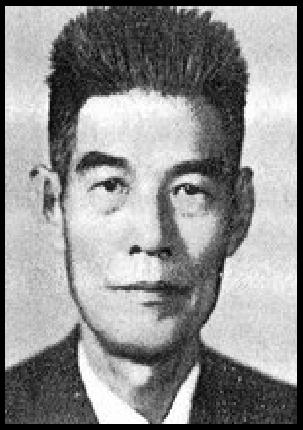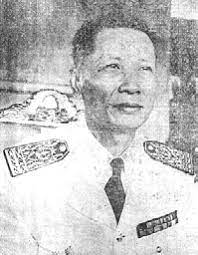The term ‘Prime Minister’ is used loosely to refer to the parliamentary Head of State- as other terms are used in Cambodian political history.
There may be major gaps in some of the profiles- which are taken from Khmer, French and English language sources. Some of the dates and days in office may not be totally correct. The names and dates in office are taken from WORLDSTATESMAN and may not always tally with other sources. Also note that some of the terms and positions have been translated from Khmer into French and then into English, so may be different to the standard.

Yem Sambaur
12 Feb 1949 – 20 Sep 1949: 220 days
29 Sep 1949 – 28 Apr 1950: 211 days (total 431 days)

Born February 2, 1913 in Kompong-Svay, Battambang. His father was a lawyer from Kampong-Cham. Yem Sambour studied at Sisowath high school in Phnom-Penh then at Albert Sarraut high school in Hanoi. He obtained the baccalaureate in 1935.
He married on May 1, 1939, and had 8 children: Syvana, Dararoat, Kirirum, Borumraot, Sereyroat, Moniroat, Bopharoat, Phalaroat.
In 1939 he entered the Cambodian magistracy, working as Deputy Commissioner of the King at the Sala Outor (Court of Appeal), the President of the Cambodian Courts of Kompong Chhnang, then of Kompong-Thom until the Japanese coup de force of 9 March 1945.
He was appointed as head of the Cambodian National Police at the beginning of 1947.
He joined the Democratic Party in April 1946 and was elected MP for Kampong Chhnang in the elections of December 1947, and was Secretary of State for the Interior, in charge of the national police under the cabinet of Chhean Vam (February 21 – August 14, 1948).
On November 19, 1948, he resigned from the Democratic Party and was active in overthrowing the Penn Nouth government.
With the support of the king, he obtained the investiture of the National Assembly to form a new cabinet (February 12 to September 19, 1949) of which he was President of the Council, Minister of the Interior and of Information. He was increasingly opposed by the Democrats, who pressured King Sihanouk to dissolve the national assembly and hold elections, and faced popular criticism for his plans to open a casino.
Sihanouk dissolved the assembly in September 1949, but his cabinet was chaired by Ieu Koeus from September 20 to 28. Just over a week later Yem Sambour regained his position (in a dissolved National Assembly) from September 29 1949 to May 2, 1950, with the additional functions of Minister of Interior and National Defense.
He accompanied the king to France in October 1949 for the signing of the Franco-Khmer treaty which took place on November 8, 1949.
He founded ‘le parti du Redressement National’, the National Redressment Party in April 1950 with former liberals like Khouth Koeun, and former Democrats including Ray Lomuth and Phelk Phoeun, however they failed to win votes in the elections of 1951 and 1955.
In June 1952, following the distribution of leaflets criticizing the National Assembly and the Democratic Party government of Huy Kanthoul, police conducted a search of his home. Weapons were found and he was arrested on June 8.
The King intervened to get him released, but Huy Kanthoul refused. Sihanouk then dissolved the government, dismissing Huy Kanthoul on June 15, 1952 and Yem Sambaur was released on June 24, 1952.
After the 1970 ousting of Sihanouk, Sambaur wrote an essay defending the National Assembly’s termination of support for the monarch.
His other roles included:
-Inspector of Finances in November 1952.
-Minister of National Economy in the cabinet of Chan Nak (November 23, 1953 – April 6, 1954).
-Minister of Finance in the King’s Cabinet (April 7-April 17, 1954).
-Minister of Budget, Trade and Industry (August 1 – January 25, 1955).
-Minister of National Economy (26 January – September 30, 1955).
-Then he became curator of the National Library.
-He joined the Sangkum in April 1959.
-Secretary of State for Agriculture (August 7 – October 6, 1962).
-Elected MP for Samrong-Thom (Kandal) in the elections of 1962. Reelected in the 1966 elections.
-In the 22nd cabinet chaired by Lon Nol:
Minister of State, in charge of Justice (25 October 1966 – 1 May 1967).
-After the coup of March 18, 1970, he became vice-president of the Council and Minister of Foreign Affairs from March 21-July 2, 1970.
-In the cabinet of July 2, 1970- May 5, 1971, he held the post of Minister of Justice, and again March 20 – October 14, 1972.
He later became the consul in Haiti and died in Paris in 1989.
Ieu Koeus
20 Sep 1949 – 29 Sep 1949: 9 days

Ieu Koeus was born in 1905 in Sangkè district, Battambang province and was educated at Kandal Pagoda and at primary school
in Battambang province. He continued his secondary education at Sisowath College in Phnom Penh. He studied at the Hanoi Business School, graduating in 1927.
He worked for Denis Frère in Phnom Penh and the Memot rubber plantation and married in 1929. He had two children.
From 1932 to 1942, he worked in Battambang. From 1942 to 1945, he set up a pharmacy depot and a soap factory.
In 1945 he became Deputy Prime Minister of the Economy. A year later he became one of the founders of the Democratic Party and was provisionally appointed as president of the National Assembly to establish the draft constitution (placing Cambodia as a constitutional monarchy). From 1947-1949, he was president of the National Assembly.
From September 20 to 28, 1949, he was appointed Prime Minister and Minister of the Interior for just 9 days, and was succeeded by his predecessor and rival Yem Sambaur. Towards the end of 1949, he accompanied King Sihanouk to France.
On returning to Phnom Penh, during the closing session of the Democratic Party on January 14, 1950, he was the victim of a grenade attack and died. The perpetrators were never caught- the French, Khmer Issarak rebels, Sihanouk’s own security forces and even the Democrats have been implicated, but no charges were ever made.
Khmer history sources talk of a fundraising campaign to construct a stupa to honor Ieu Koeus next to that of his friend and political mentor Sisowath Youtevong.
Despite opposition, an overwhelming majority of Democrat lawmakers voted to pass a special law, forcing both townspeople and farmers to pay a contribution of five French Francs per household to contribute to the construction of the stupa. However, on completion, the stupa was somewhat modest- and although previous promises had stated that any remaining money would be transferred over to the state budget- a sizeable amount of money raised vanished.
The period between the death of Prince Youtevong in 1947 and the death of Ieu Koeus in 1948 is described by Sakou Samoth in his French language work HOMMES ET HISTOIRE DU CAMBODGE
“After the death of Prince Youtevong, the Democratic Party elected the grandson of King Sisowath, Prince Sisowath Vachhayavong (alternatively spelled Watchayavong), to be Prime Minister from 25 July 1947 to 20 February 1948.
Afterwards, the party elected Chhean Vam to succeed Prince Sisowath Vachhayavong. However, due to some infighting, the Prime Minister found his power insufficient and could not get things done. He asked for more power but the request was turned down.
Chhean Vam was overthrown on that issue in 14 August 1948 and Penn Nouth was elected as the next Prime Minister. He did not remain long at the head of his cabinet because Yem Sambaur, a former member of the Democratic Party, accused Penn Nouth of corruption. Yem Sambaur had left the Democratic Party to form his own minority grouping. Inexplicably, Yem Sambaur was chosen as the next Prime Minister on 12 February 1949 to replace Penn Nouth. How could this happen since the Democratic Party had the majority of the vote? The only reason this curious event could be explained was that the members of the Democratic Party became jealous of each other and preferred to see somebody from the outside instead of one of their own becoming Prime Minister.
After Yem Sambaur became Prime Minister, the Democrats started to have second thoughts and they finally passed a motion of censure against the Prime Minister- the nature of the censure was not clear. Because of this action, on 18 September 1949 King Norodom Sihanouk dissolved the National Assembly and signed a treaty with France granting some independence for Cambodia.
The treaty granted Khmer people most of administrative functions within Cambodia. In addition, the provinces of Battambang and Siem Reap that the French recovered from the Thai were given to the Cambodian government for self-governing rule with its own armed forces without any French interference. This was called the autonomous zone, similar to the autonomous zone of Pailin that Hun Sen granted to the remnants of Khmer Rouge. (These areas were also the areas where rebel group the Khmer Issarak- forerunner of the Khmer Rouge would be most active)
However, on matters of foreign policy, the Cambodian government had to coordinate its actions and decision making with the French Union. The French retained most of the judicial systems, finances, and customs. Outside Battambang and Siem Reap, France retained military operations. The reason the French wanted to retain military operations on other parts of Cambodia was because they felt more of a threat coming from Vietnam than Thailand, a threat that could break the French Union.
According to the Constitution at the time, in the event of the dissolution of the National Assembly, the President of the Assembly would become the chief executive pending the holding of new elections. At the time, Ieu Koeus was President of the Assembly. Unfortunately, he was assassinated in January 1950. Theories abounded on who assassinated Ieu Koeus. Some claimed it was Yem Sambaur himself who had a hand behind the whole affair while some pointed the fingers at Prince Norindeth. However, this case had never been resolved and still remains a mystery to this day.“
Sisowath Monipong
30 May 1950 – 3 Mar 1951: 277 Days

Sisowath Monipong was born on August 25, 1912, the son of His Majesty Sisowath Monivong and Her Royal Highness Princess Kanviman, and the younger brother of Sihanouk’s mother Sisowath Kossomak.
In 1930, he became a monk for a year at the Botum Vaddey monastery.
In 1939, he entered the French Air Force and participated in operations in Europe until the 1940 fall of France. In 1946, Prince Monipong began his political life of his country after he was appointed Royal Delegate for Health, Sports and National Economy, then he became Minister of National Education in the government chaired by Prince Sisowath Monireth, his brother.
In May 1949 he was appointed Director General of the Royal Palace services. In November of the same year represented Cambodia in Paris for the signing of the first Franco-Khmer treaty- the Union française– which saw the Fourth Republic aim to incorporate all former colonies into a single French Union with all subjects classed as French citizens.
Sisowath Monipong became President of the Council of Ministers (Prime Minister) in 1951. Following his nephew Sihanouk’s abdication 1955, he was sent to Paris as High Commissioner of Cambodia (Ambassador) in France. On August 31, 1956, he died of a heart attack in Paris aged just 44. His remains were brought back to Cambodia and cremated according to royal tradition and his ashes laid in the stupa of king Sisowath Monivong, on Phnom Preah Reach Troap at Oudong. His ashes were deposited by his eldest son, one his 13 children, Prince Sisowath Samyl Monipong.
Oum Chheang Sun
3 Mar 1951 – 12 Oct 1951: 223 days
4 Jan 1956 – 29 Feb 1956: 56 days
Total: 279 days

Oum Chheang Sun was born on June 1, 1900 in Kompong-Cham, the son of Mok Oum and Neang Séa. Originally a member of the Democratic Party, he was an educator, and later
He did his primary studies in Kompong-Cham and secondary studies at Lycee Sisowath, from where he graduated in 1918.
He became a school teacher on August 21, 1918, and later director and Inspector of Kampot Schools in 1927 and 1928.
From 1928 to 1929, he trained at the Higher School of Pedagogy in Hanoi and after completing his studies became Secretary of the Directorate of Education in Cambodia between 1929 to 1930.
From September 1930 to September 1933, he was Inspector of Primary Education in the Kampot, Takeo, Kompong-Speu sector, and then Inspector assistant to His Majesty’s Personal Delegate for Traditional Education from 1933 to 1942.
He was actively involved in the renovation of Pagoda Schools- the main source of education for the majority of Cambodians- and the organization of Provincial Application Schools in collaboration with the French education reformer Louis Manipoud.
At the same time, from 1936 to 1944, was responsible for the organization of the Pagoda Schools across Cochinchina, and became the first Indochinese Inspector after passing his examinations in September 1942.
Oum Chheang Sun became Chief Inspector of Education at the Ministry of Education from 1942 to 1945 and was one of the first editors of the Khmer schools and the Primary Education Bulletin.
From October 1945 to January 1946, he held the posts of Chief Inspector and Principal of Lycée Sisowath.
He entered into politics around 1948 to 1949, and he was made a member of the Kingdom Council- becoming Chairman from January 1950 to February 1952.
He was President of the Council of Ministers and Minister of Defense from March 3 – May 13, 1951 and was formally Prime Minister from May 14 – October 12, 1951.
After his brief time in office, he became Director General of Public Instruction from 1952 to 1954, Minister of Public Health (January 26- September 30, 1955), Private Counsel to the Crown from 1954 to 1955 and a member of the High Council of the Throne from July 1, 1955.
Following the first legislative elections under the Sangkum in 1955, he was elected deputy for the constituency of Mien (Kampong Cham) and First President of the National Assembly (elected in October 1955).
He became President of the Council of Ministers (Prime Minister) and Minister of the Interior and Health in the 2nd Sangkum government from January 6 – March 1956.
Oum Chheang Sun died in 1963, details of his passing have no been found.
He was married to Neang Nginn Léang and had two children named Sangim and Saône.
His brother Oum Chheang Nguon was governor of the provinces of Stung-Treng and Siemreap, Head of the Civil House of the King and Ambassador to Laos.
Although Oum Chheang Sun only had brief spells in top office, he is remembered for his reforms of Khmer school administration system.
Huy Kanthoul
13 Oct 1951 – 16 Jun 1952: 247 days

Huy Kanthoul was born on February 1, 1909 in Phnom-Penh to Huy Plok and Neang Lé.
He married Neang Ly Si Pho in 1933 and the couple had 5 children: Kanthary, Kinthara, Noracsy, Vora and Kavouth.
Like his predecessor, he was an educator who studied at Lycee Sisowath in Phnom-Penh and at the Ecole Supérieure of Pedagogic in Hanoi- gaining his diploma in 1931. He was assigned to Sisowath high school where he began his teaching career.
In 1937 Huy Kanthoul received a travel grant, allowing him to go to France where he stayed for 5 months.
From 1943-44, he was appointed delegate for Information, Propaganda and Press, a newly created post under the Ministry of National Education.
He was of member of several notable associations, such as vice-president of the “Amical des Anciens” for former students of Sisowath high school, and also one of the founders with Pann Yung, Penn Nouth and Thonn Ouk of the “Office of Cambodian Students in France”, and member of the “Advisory Council on Public Education”.
From 1946, he became a member of the Democratic Party where he had a post on the Steering Committee.
Roles before taking office:
-Secretary of State for Information and Propaganda in the 4th Government of Cambodia under Prince Sisowath Youthevong (December 15 1946-24 July 1947).
-In 1947, he was elected Deputy of the Democratic Party.
-Minister of Information and Social Action in the government of Prince Watchayavong (July 25, 1947 -February 20, 1948).
-Minister of Worship, Fine Arts and Social Action in the government of Cambodia under Chhean Vam (February 21 – August 14, 1948).
-Minister of National Education, Sports and Youth in the 7th Government of Cambodia under Penn Nouth (August 15, 1948 – February 11 1949).
-September 18, 1949, he was appointed secretary general of the Democratic Party in replacement of Ieu Koeus. He resigned in 1950 and was replaced by Khuan Nay.
In March 1950, he was appointed a member of the Commission for the Application of the Franco-Khmer Treaty (Cultural Affairs – Press and Information), and from May 16 to December 29, 1950, he returned again to France.
-Minister of National Education and Youth in the 13th government of Cambodia chaired by Sisowath Monipong (January 1 – March 1951)
-Minister of National Education and Fine Arts in the 14th Government of Cambodia chaired by Oum Chheang Sun (March 3 – May 13 1951).
-President of the Council (Prime Minister and Minister of Social Action in the 16th government of Cambodia (October 13, 1951 – June 15, 1952). This cabinet was the last government chaired by the Democrats, and was dissolved by King Sihanouk, apparently with the blessing of France.
With the Democrats now a politically spent force, Huy Kanthoul stepped back from national politics. After independence he became Consul General in Hong Kong and Ambassador Extraordinary and Plenipotentiary to Moscow in 1965.
He died in Paris on September 13, 1991.
After King Sihanouk took control of government for the 3rd time (June 16 1952 – January 24 1953), he rushed forward his plans for independence from France. The king appointed Penn Nouth as Prime Minister (his second time) and gave him the command of the Khmer Royal Army before going into self-imposed exile in Siam.
Nouth oversaw the formal declaration of independence on November 9, 1953 and was the first Prime Minister of the Kingdom of Cambodia until November 22, when he was replaced by Chan Nak.

One thought on “Cambodian Prime Ministers 2: 1949-Independence”